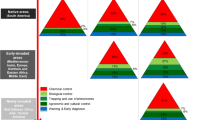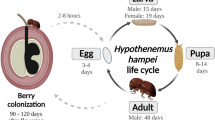Abstract
Experimental studies were conducted at Entomology Farm, Sher-e-Kashmir University of Agricultural Sciences and Technology of Jammu for two consecutive years (2021–22 and 2022–23) to evaluate the effect of different insecticides against the larval population of Helicoverpa armigera Hubner and the foraging behavior of leafcutter bees in chickpea. The present study recorded six leafcutter bee species within the family Megachilidae and order Hymenoptera (Megachile hera Bingham, M. conjuncta Fabricius, M. lanata Fabricius, Pseudomegachile sp., Osmia sp., and Coelioxys sp.) foraging on chickpea flowers. Four bio-insecticides (B. thuringiensis var. kurstaki, Ha-NPV, NSKE, Neem oil) and three synthetic insecticides (Spinosad, Novaluron, Emamectin benzoate) along with control were evaluated for their efficacy against target pest and pollinators. The foraging of leafcutter bees was significantly higher in bio-insecticide-treated plots than in synthetic-insecticide-treated plots. B. thuringiensis and Ha-NPV were at par in reducing the maximum larval population of H. armigera while causing the least disturbance in the foraging behavior of leafcutter bees. In contrast, synthetic insecticide-treated plots witnessed the least foraging by the pollinators on chickpea flowers.


Similar content being viewed by others
References
Akhtar LH, Pervez MA, Nasim M (2011) Genetic divergence and inter relationship studies in chickpea Cicer arietinum L. Pak J Agric Sci 48:35–39
Aoun M (2020) Pesticides’ impact on pollinators. In: Leal FW, Azul A, Brandli L, Özuyar P, Wall T (eds) Zero hunger. Springer
Arain GN (2012) Chick peas cultivation in Pakistan. Available from http://www.valleyirrigationpakistan.com/wp-content/uploads/2012/09/CHICKPEASCULTIVATION-IN-PAKISTAN.pdf
Biddinger D, Rajotte EG (2015) Integrated pest and pollinator management-adding a new dimension to an accepted paradigm. Curr Opin Insect Sci 10:204–209
Brittain CA, Vighi M, Bommarco R, Settele J, Potts SG (2010) Impacts of a pesticide on pollinator species richness at different spatial scales. Basic Appl Ecol 11(2):106–115
de Oliveira AC, Junqueira CN, Augusto SC (2019) Pesticides affect pollinator abundance and productivity of sunflower (Helianthus annuus L.). J Api Res 58(1):2–8
Devi VPS, Duraimurugan P, Chandrika PKSV, Vineela V, Hari PP (2020) Novel formulations of Bacillus thuringiensis var. kurstaki: an eco-friendly approach for management of lepidopteran pests. World J Microbiol Biotechnol 36(5):78
Feltham H, Park K, Goulson D (2014) Field realistic doses of pesticide imidacloprid reduce bumblebee pollen foraging efficiency. Ecotoxicol 23:317–323
Fohouo FNT, Ngakou A, Kengni BS (2009) Pollination and yield responses of cowpea (Vigna unguiculata L. Walp.) to the foraging activity of Apis mellifera Adansonii (Hymenoptera: Apidae) at Ngaounde’re´ (Cameroon). Afr J Biotechnol 8:1988–1996
Gill RJ, Ramos-Rodriguez O, Raine NE (2012) Combined pesticide exposure severely affects individual and colony level traits in bees. Nature 491:105–108
Jukanti AK, Gaur PM, Gowda CLL, Chibbar RN (2012) Nutritional quality and health benefits of chickpea (Cicer arietinum L.): a review. Britain J Nutr 108:11–26
Karim S (2000) Management of Helicoverpa armigera: a review and prospects for Pakistan. Pak J Biol Sci 3:1213–1222
Kranthi KR, Jadhav DR, Kranthi S, Wanjari RR, Ali SS, Russell DA (2002) Insecticides resistance in five major insect pests of cotton in India. Crop Prot 21:449–460
Kumar A, Tripathi MK, Chandra U, Veer R (2019) Efficacy of botanicals and bio-pesticide against Helicoverpa armigera in chickpea. J Entomol Zool Stud 7(1):54–57
Latif A, Malik SA, Saeed S, Iqbal N, Saeed Q, Khan KA, Ting C, Ghramh HA (2019) Diversity of pollinators and their role in the pollination biology of chickpea, Cicer arietinum L. (Fabaceae). J Asia Pacific Entomol 22:597–601
Michener CD (2007) The bees of the world, 2nd edn. The John Hopkins University Press, Baltimore, MD
Mommaerts V, Jans K, Smagghe G (2010) Impact of Bacillus thuringiensis strains on survival, reproduction and foraging behaviour in bumblebees (Bombus terrestris). Pest Manage Sci 66(5):520–525
Mukhtar Y, Shankar U (2023) Integrated pest and pollinator management in India: A way forward to sustainable agriculture. Indian J Agric Sci 93(9):939–947 https://doi.org/10.56093/ijas.v93i9.134403
Nauman K, Currie RW, Isman MB (2012) Evaluation of the repellent effects of a neem insecticide on foraging honey bees and other pollinators. Can Entomol 126(2):225–230
Rani AT, Kammar V, Keerthi MC, Rani V, Majumder S, Pandey KK, Singh J (2021) Biopesticides: an alternative to synthetic insecticides. In: Bhatt P, Gangola S, Udayanga D, Kumar G (eds) Microbial technology for sustainable environment. Springer, Singapore. https://doi.org/10.1007/978-981-16-3840-4_23
Ravi M, Satharam G, Sathiah N (2008) Ecofriendly management of tomato fruit borer, Helicoverpa armigera (Hubner). J Biopestic 1(2):134–137
Ruttoh EK, Mulwa RMS, Ngode L, Gohole L, Towett B, Njogu N, Silim S, Rao GVR, Kimurto PK (2013) Screening for host plant resistance to Helicoverpa armigera (Lepidoptera: Noctuidae) in selected chickpea (Cicer arientinum L.) genotypes in Kenya. Egerton J Sci Technol 13:39–55
Sarwar M (2013) Exploration on resource of resistance in chickpea (Cicer arietinum L.) genotypes against gram pod borer Helicoverpa armigera (Hubner) (Lepidoptera). Afr J Agricul Res 8:3431–3435
Sarwar M, Ahmad N, Tofique M (2009) Host plant resistance relationship in chickpea (Cicer arietinum L.) against gram pod borer (Helicoverpa armigera Hubner). Pak J Botany 41:3047–3052
Shankar U, Abrol DP (2015) Role of pollination in pulses. In: Raju AJS (ed) Advances in pollen spore research. Today & Tomorrow’s Printers and Publishers, New Delhi
Shankar U, Mukhtar Y (2023) Pest management practices impact Helicoverpa armigera infestation and foraging behaviour of pollinators in sunflower. Int J Pest Manag. https://doi.org/10.1080/09670874.2023.2216667
Shiberu T, Nageri M (2014) Evaluation of insecticides and botanicals against onion thrips Thrips tabaci (L.) (Thysanoptera:Thripidae). Entomol Appl Sci Lett 1:26–30
Shrestha R, Neupane RK, Adhikari NP (2011) Status and future prospects of pulses in Nepal. Paper presented at regional workshop on pulse production held at Nepal Agriculture Research Council (NARC), Kathmandu, Nepal, from 24-25 October 2011. http://www.doanepal.gov.np/downloadfile/Current%20Status%20SAARC_paperNepal_1320838291
Spoorthi GS, Singh R, Sharma R, Kumar A, Singh N, Tomar SS (2017) Efficacy of insecticide and bio pesticides against Helicoverpa armigera (Hubner) on chickpea in Western Uttar Pradesh. J Pharmacog Phytochem 1:1034–1039
Surya PG, Sawai HR, Kothikar RB, Patil MJ (2021) Evaluation of Ha-NPV against Helicoverpa armigera in chickpea. Int J Chem Stud 9(5):23–26
Tschoeke PH, Oliveira EE, Dalcin MS, Silveira-Tschoeke MCA, Sarmento RA, Santos GR (2019) Botanical and synthetic pesticides alter the flower visitation rates of pollinator bees in Neotropical melon fields. Environ Poll 251:591–599
Zaman K, Shah IA, Khan MM, Ahmad M (2012) Macroeconomic factors determining FDI impact on Pakistan’s growth. South Asian J Buss Res 1:79–95
Funding
No funding was received for the present research.
Author information
Authors and Affiliations
Contributions
US contributed to conceptualization, conducted experiment, and data collection. US contributed to data tabulation and analysis, draft writing, and methodology.
Corresponding author
Ethics declarations
Conflict of interest
Authors declare no conflict of interest.
Additional information
Publisher's Note
Springer Nature remains neutral with regard to jurisdictional claims in published maps and institutional affiliations.
Rights and permissions
Springer Nature or its licensor (e.g. a society or other partner) holds exclusive rights to this article under a publishing agreement with the author(s) or other rightsholder(s); author self-archiving of the accepted manuscript version of this article is solely governed by the terms of such publishing agreement and applicable law.
About this article
Cite this article
Shankar, U., Mukhtar, Y. Empirical studies of integrated pest and pollinator management (IPPM) in chickpea (Cicer arietinum L.). J Plant Dis Prot 131, 201–208 (2024). https://doi.org/10.1007/s41348-023-00819-4
Received:
Accepted:
Published:
Issue Date:
DOI: https://doi.org/10.1007/s41348-023-00819-4




